
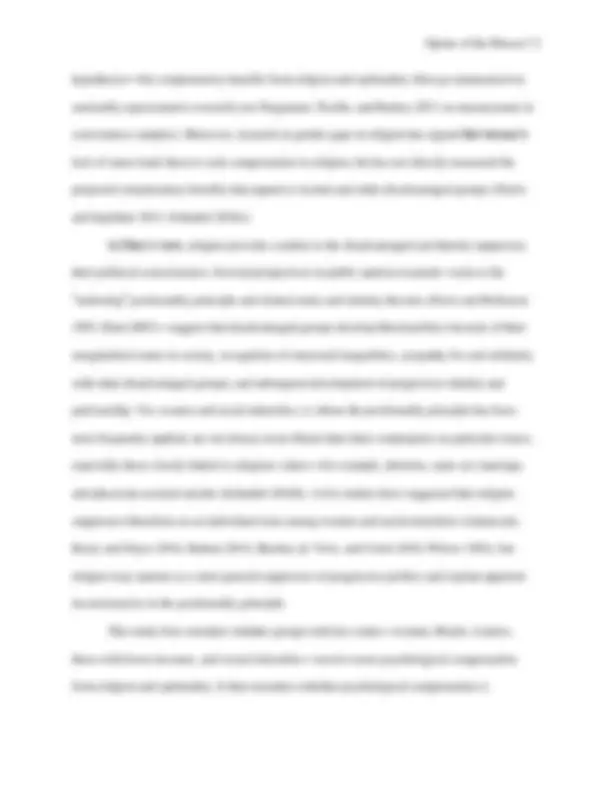
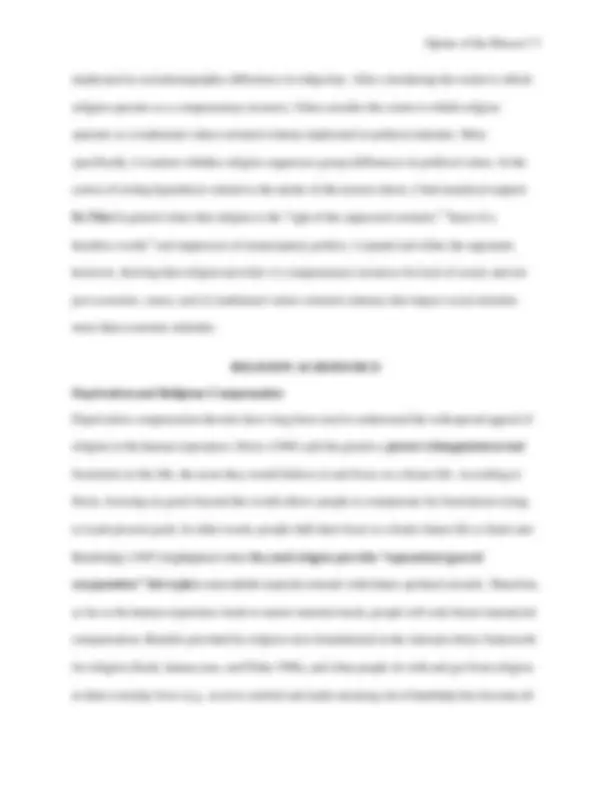
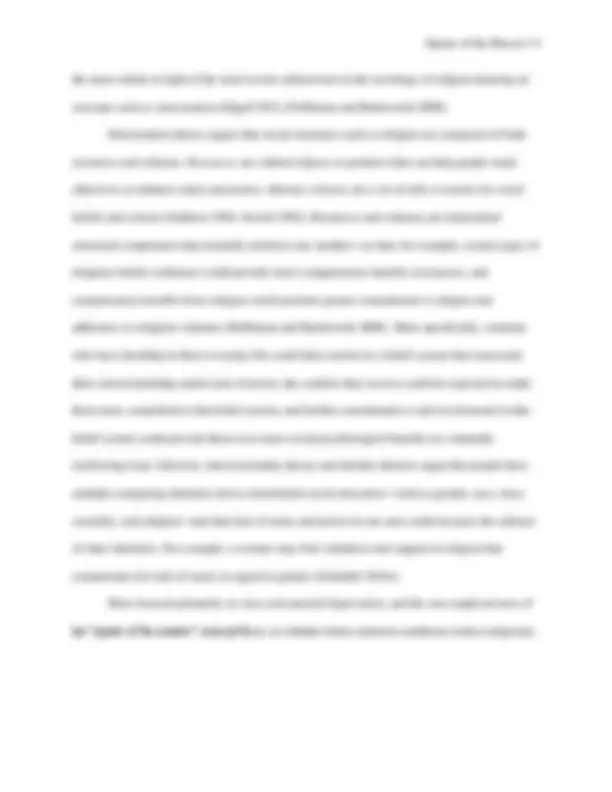
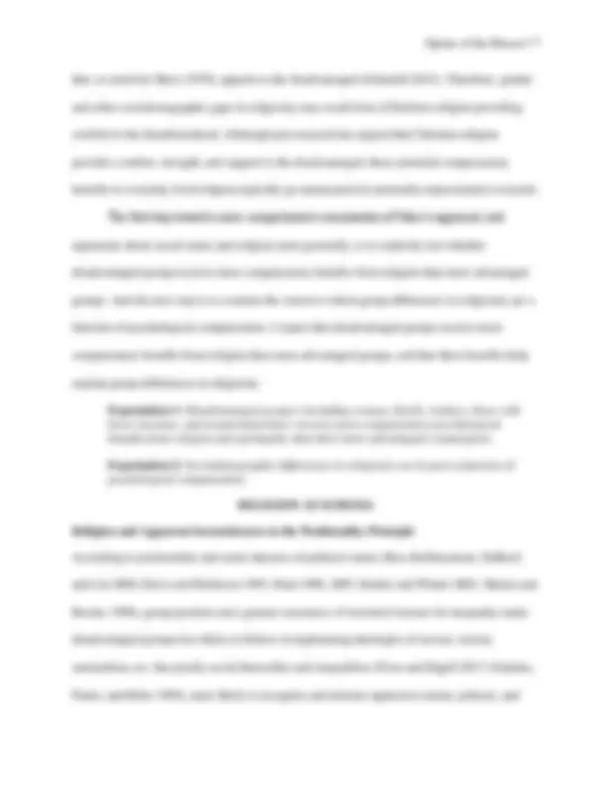
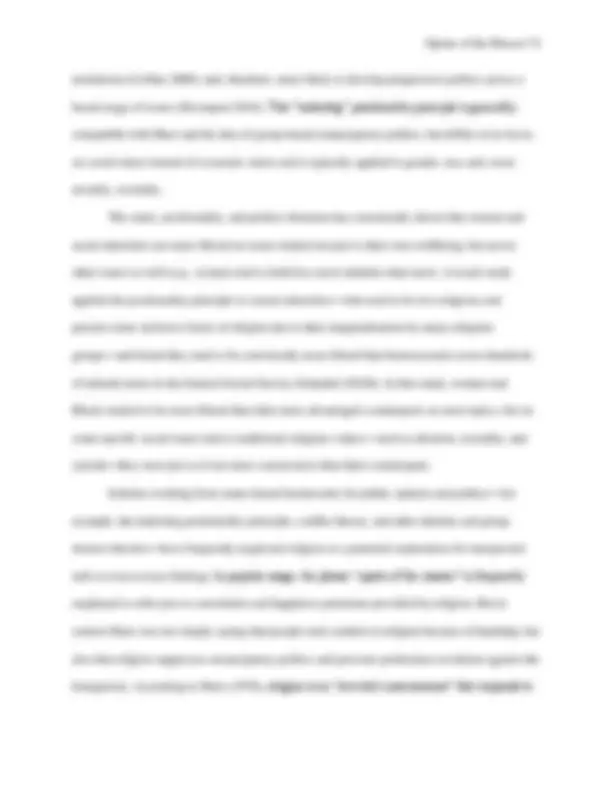
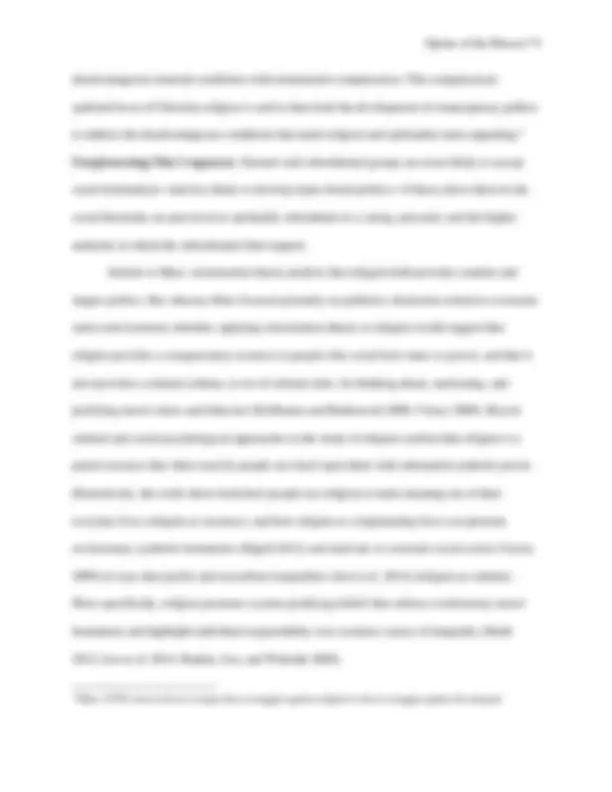
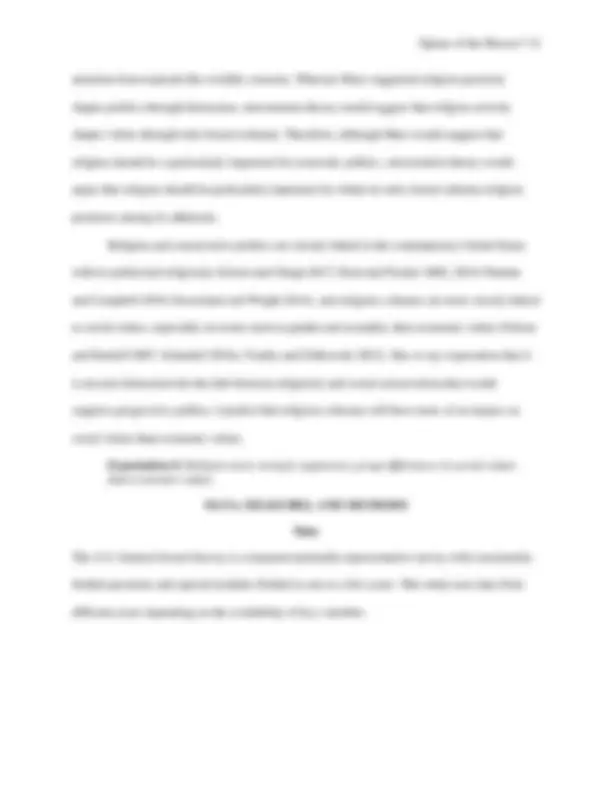


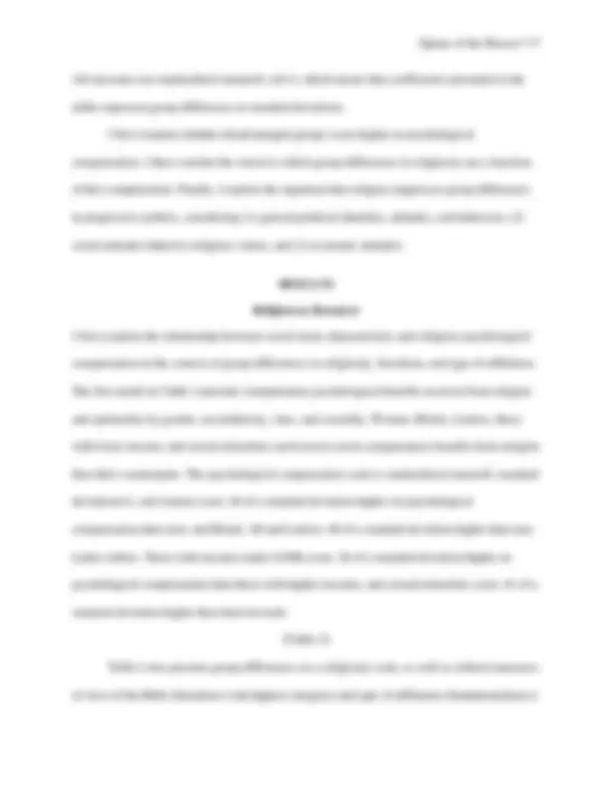
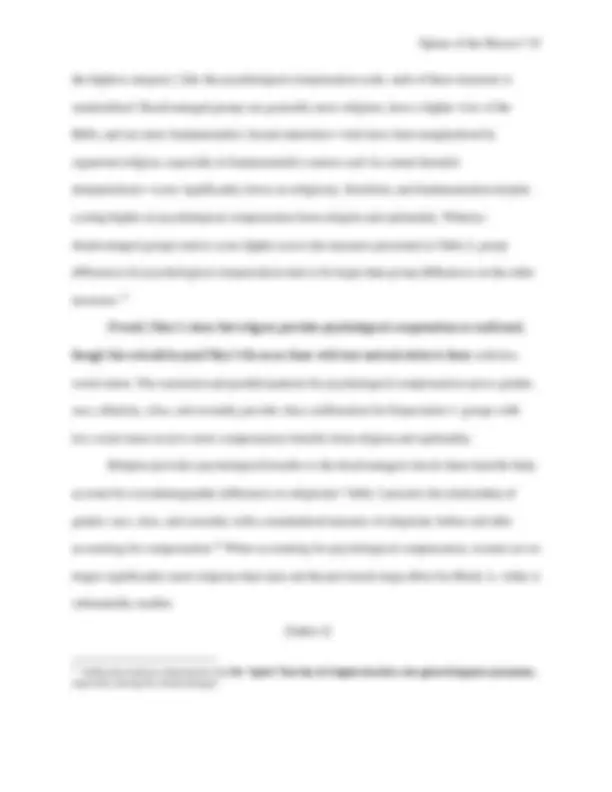
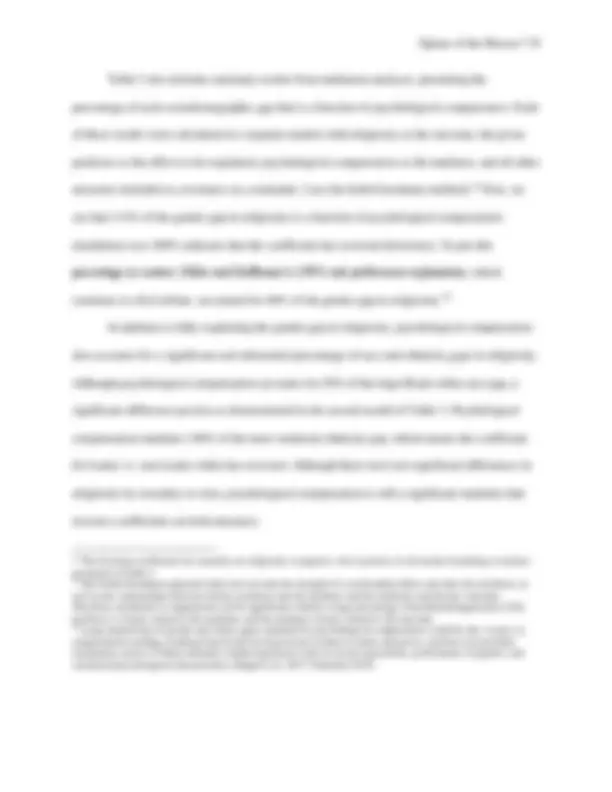
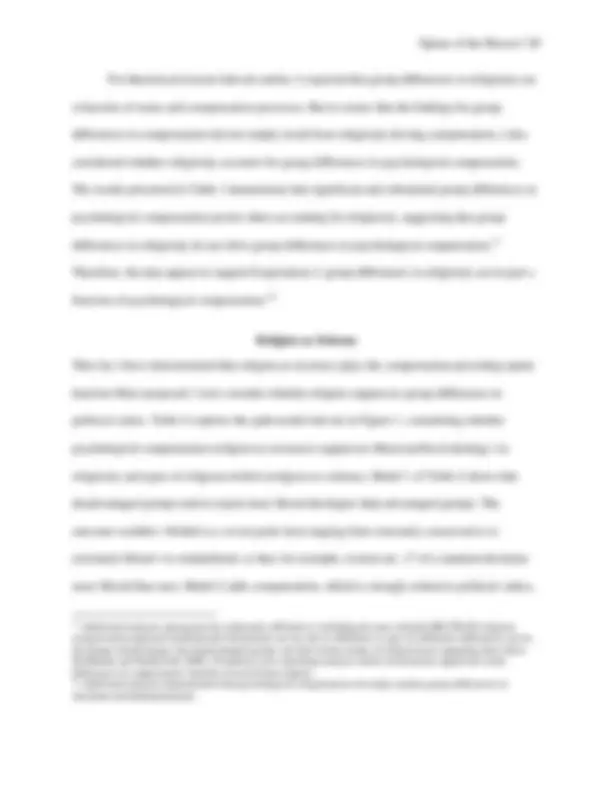
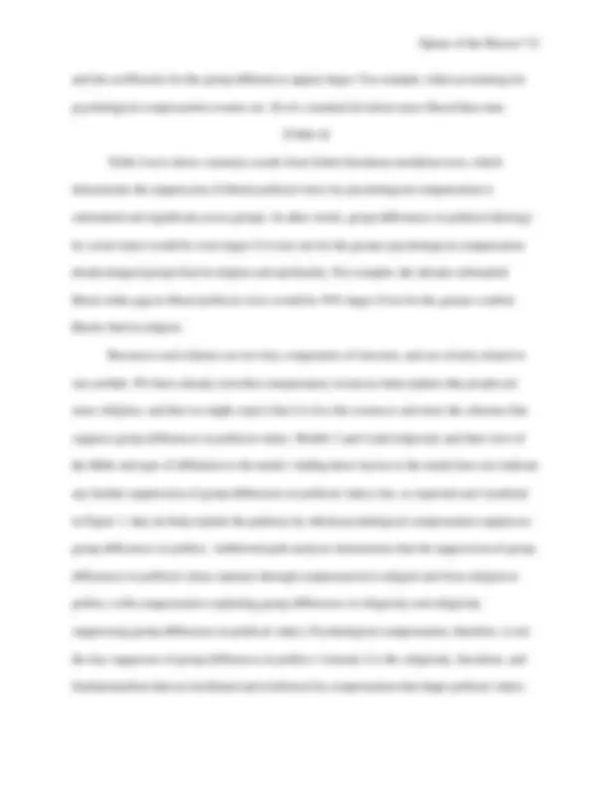
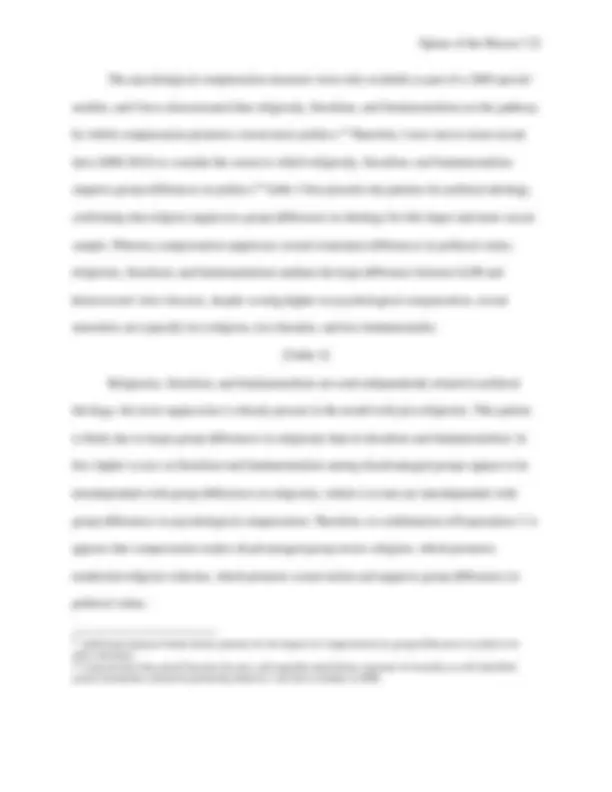
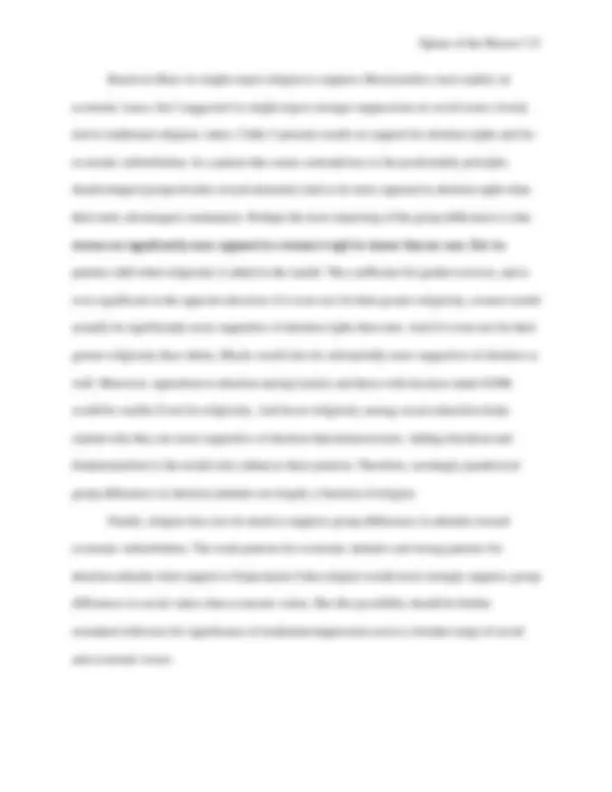
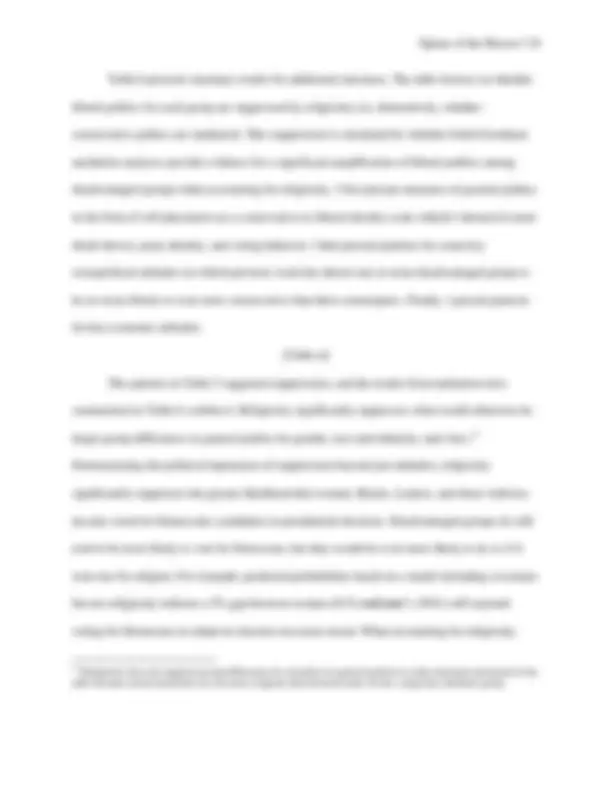
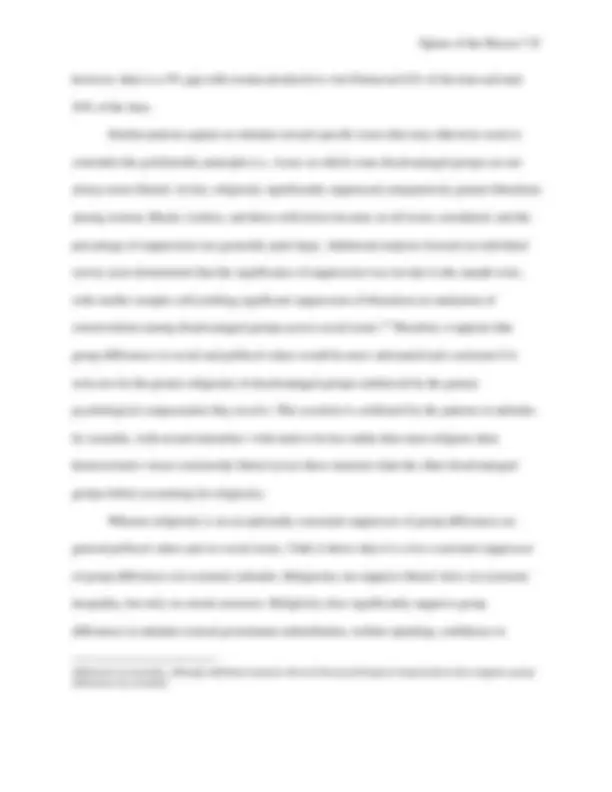
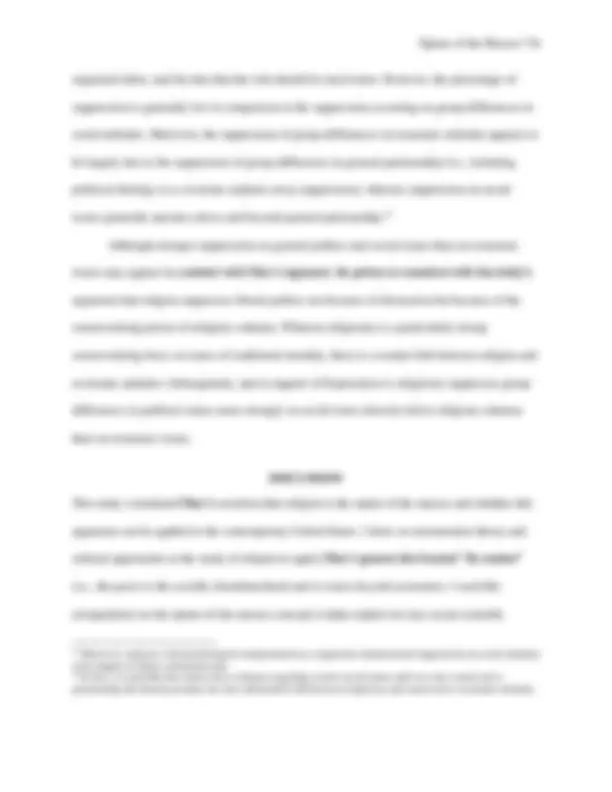
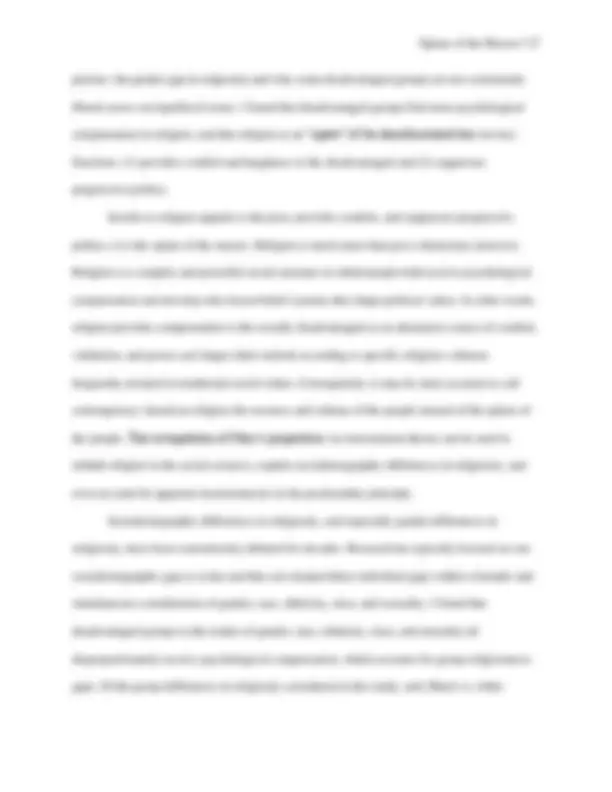
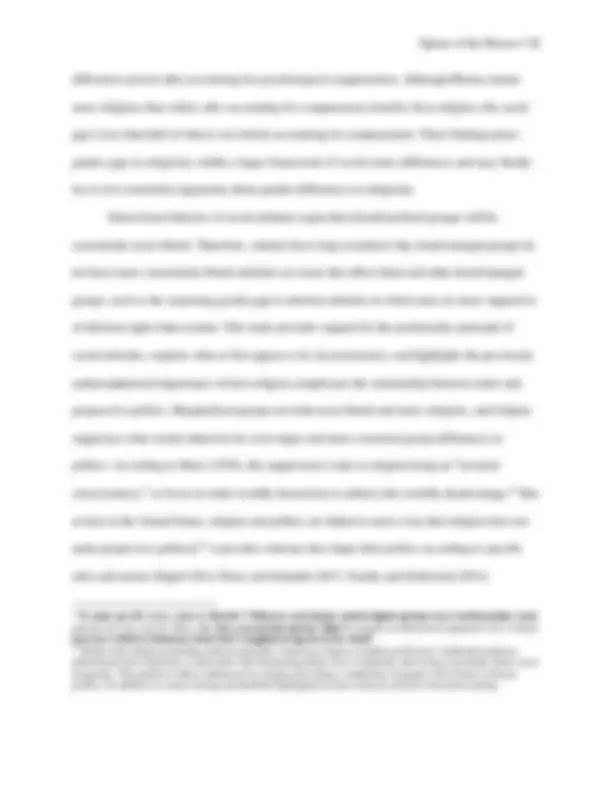
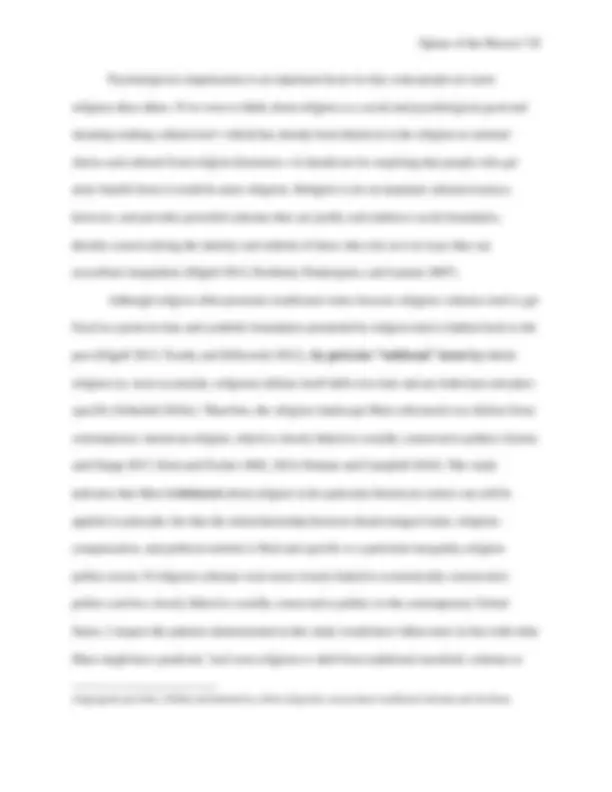

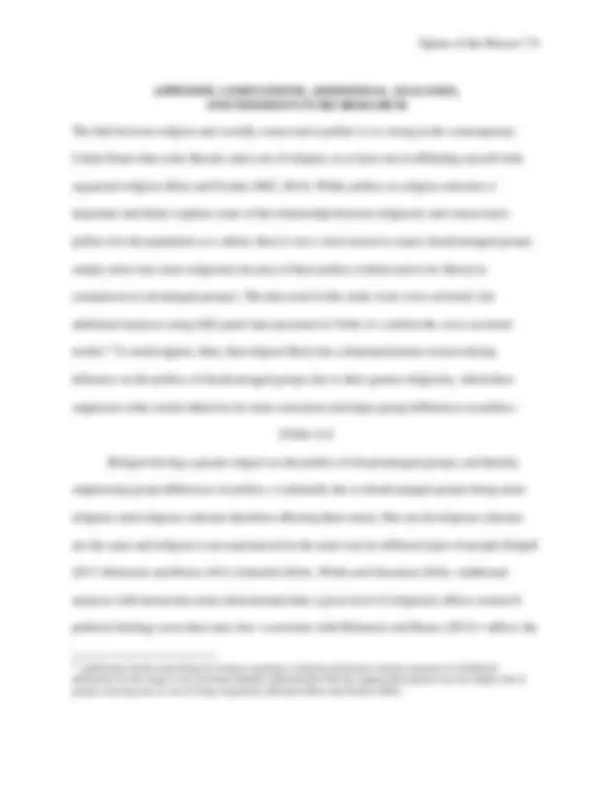
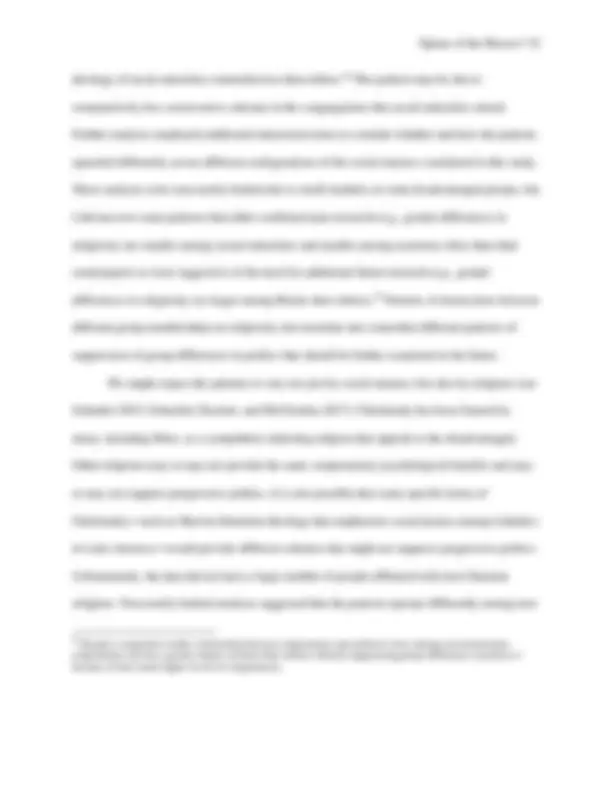

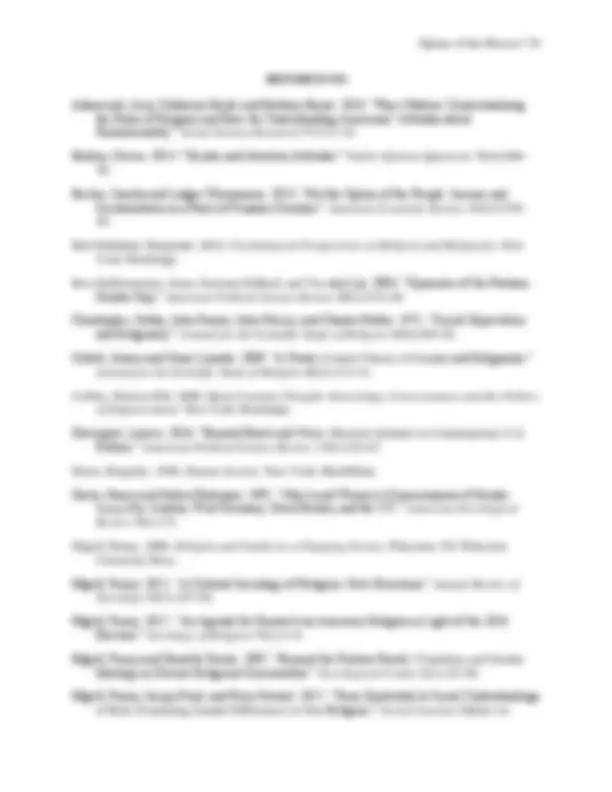
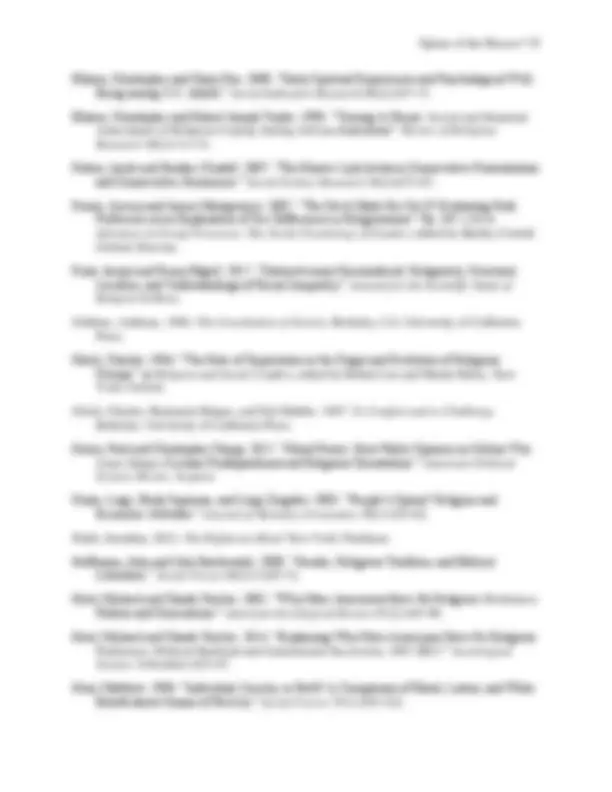
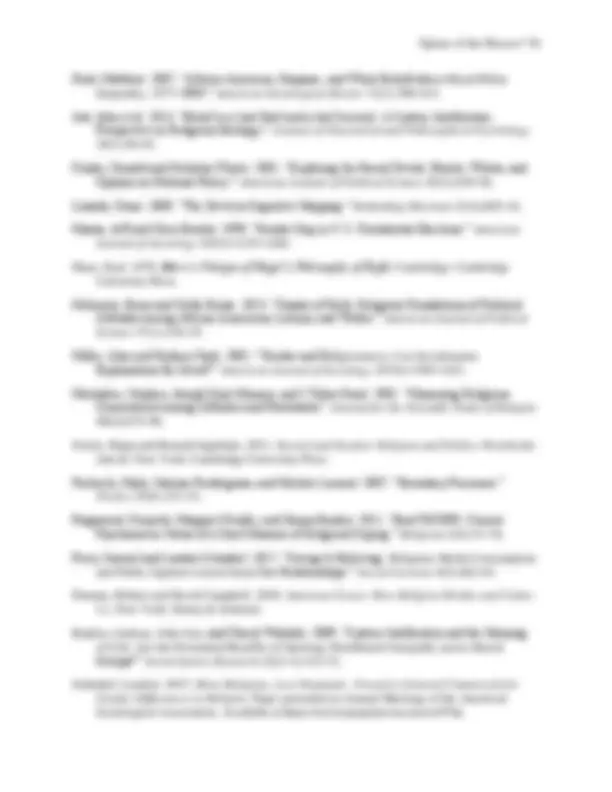
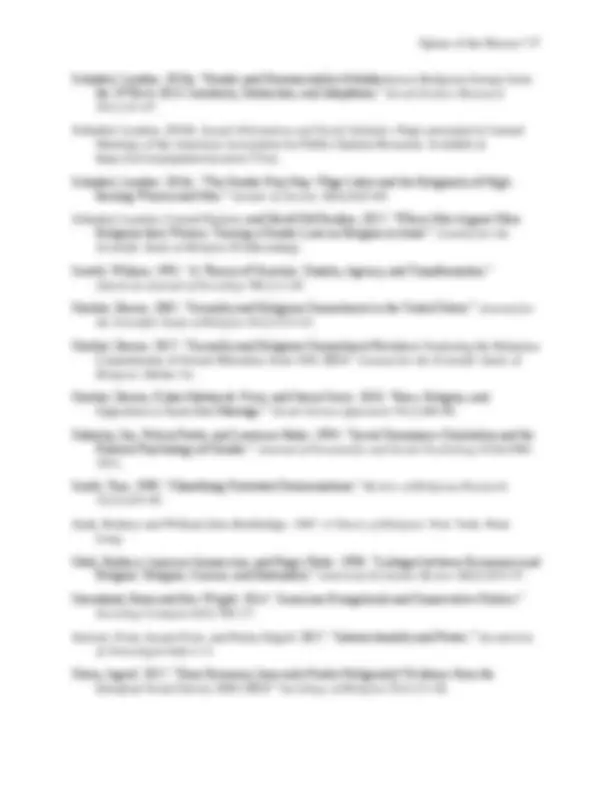

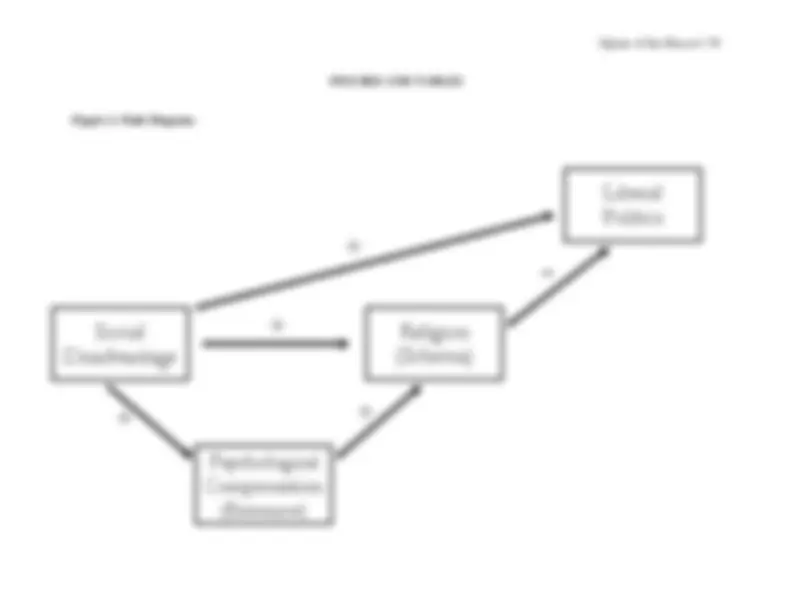
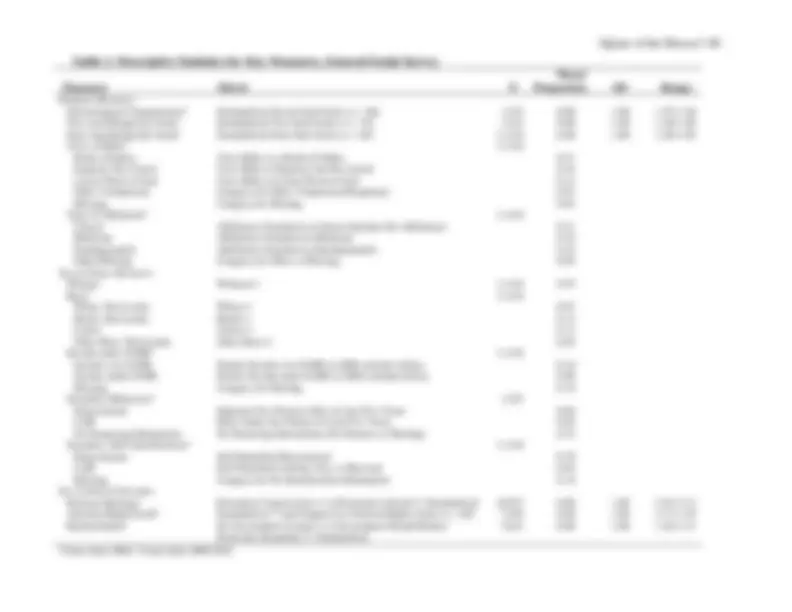


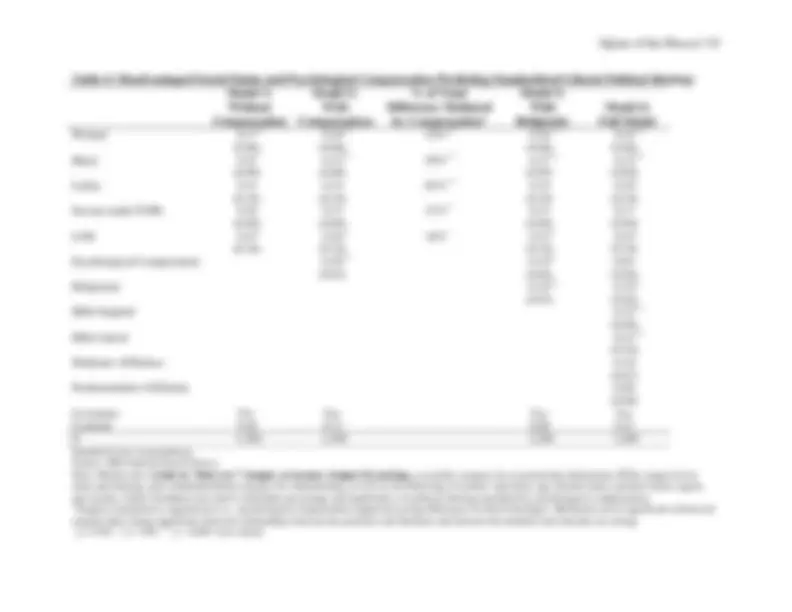
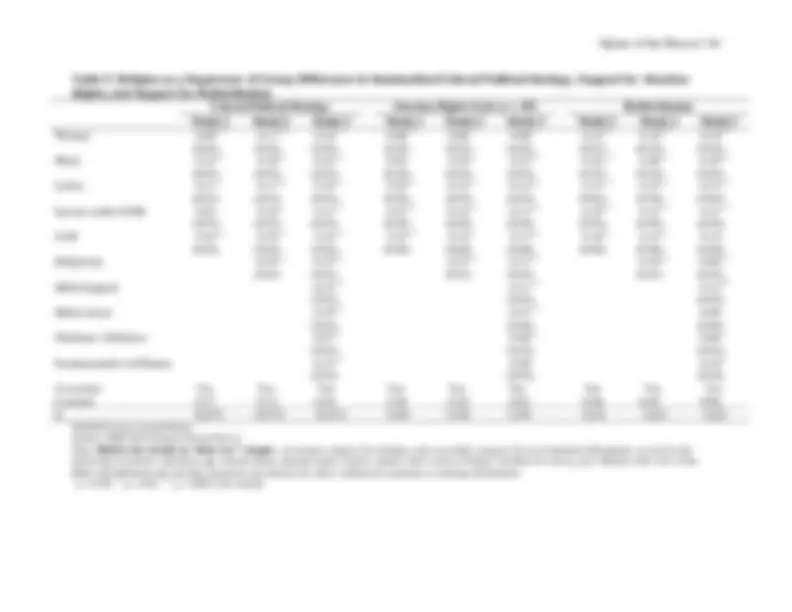
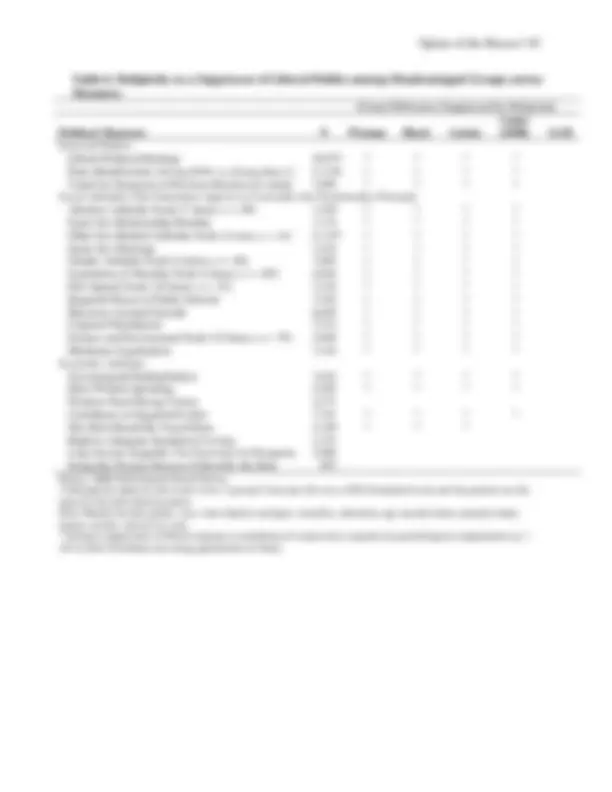



Study with the several resources on Docsity

Earn points by helping other students or get them with a premium plan


Prepare for your exams
Study with the several resources on Docsity

Earn points to download
Earn points by helping other students or get them with a premium plan
Community
Ask the community for help and clear up your study doubts
Discover the best universities in your country according to Docsity users
Free resources
Download our free guides on studying techniques, anxiety management strategies, and thesis advice from Docsity tutors
The relationship between religion and political values, focusing on how religion suppresses group differences in political values. The study finds that disadvantaged groups receive more psychological compensation from religion, which in turn makes them more religious and promotes traditional religious schemas that suppress group differences in politics. The research suggests that religion has a greater impact on the politics of disadvantaged groups, particularly on social issues, and that this suppression operates above and beyond general partisanship.
Typology: Schemes and Mind Maps
1 / 47

This page cannot be seen from the preview
Don't miss anything!








































Landon Schnabel * Indiana University, Bloomington Abstract: This study considers the assertion that religion is the opiate of the masses. Using a special module of the General Social Survey and drawing on structuration and positionality theories, Ifirst demonstrate that religion functions as a compensatory resource for disadvantaged groups— women, racial minorities, those with lower incomes, and, to a lesser extent, sexual minorities. I then demonstrate that religion—operating as both palliative resource and values-shaping schema—suppresses what would otherwise be larger group differences in political values. This study oppressed creat provides empirical support for Marx’s general claim that religion is theure” and suppressor of emancipatory politics. It expands upon and refines the “sigh of the economics-focused argument, however, showing that religion provides (1) compensatory resources for lack of social, and not just economic, status, and (2) traditional-values-oriented schemas that impact social attitudes more than economic attitudes. I conclude that religion is not a simple distraction, but instead a complex and powerful social structure in which people bothreceive psychological compensation and develop rules-based belief systems that shape their political values. Key Words: Inequality; Religion; Politics; Attitudes; Gender; Race; Ethnicity; Class; Sexuality
Last Revised: 1/4/ Running Head: Opiate of the Masses? Word Count: 11, Figures: 1 Tables: 7
THIS IS A DRAFT. DO NOT QUOTE OR CIRCULATE WITHOUT AUTHOR PERMISSION.
Religious suffering is, at one and the same time, the expression of real suffering and a protest against real suffering. Religion is the sigh of the oppressed creature, the heart of a heartless world, and the soul of soulless conditions. It is the opium of the people.
(^1) Weber similarly argued that other-worldly religion can alleviate this-worldly suffering and Durkheim that religion legitimates social arrangements.
implicated in sociodemographic differences in religiosity. After considering the extent to which religion operates as a compensatory resource, I then consider the extent to which religion operates as a traditional-values-oriented schema implicated in political attitudes. More specifically, I examine whether religion suppresses group differences in political values. In the course of testing hypotheses related to the opiate-of-the-masses thesis, I find empirical support for Marx’s general claim that religion is the “sigh of the oppressed creature,” “heart of a heartless world,” and suppressor of emancipatory politics. I expand and refine the argument, however, showing that religion provides (1) compensatory resources for lack of social, and not just economic, status, and (2) traditional-values-oriented schemas that impact social attitudes more than economic attitudes.
RELIGION AS RESOURCE Deprivation and Religious Compensation Deprivation-compensation theories have long been used to understand the widespread appeal of religion in the human experience. Davis (1948) said the greater a person’s disappointment and frustration in this life, the more they would believe in and focus on a future life. According to Davis, focusing on goals beyond this world allows people to compensate for frustrations trying to reach present goals. In other words, people shift their focus to a better future life as Stark and Bainbridge (1987) highlighted when they said religion provides “supernatural general compensators” that replace unavailable material rewards with future spiritual rewards. Therefore, as far as the human experience leads to unmet material needs, people will seek future immaterial compensation. Benefits provided by religion were foundational in the rational-choice framework for religion (Stark, Iannaccone, and Finke 1996), and what people do with and get from religion in their everyday lives (e.g., receive comfort and make meaning out of hardship) has become all
the more salient in light of the more recent cultural turn in the sociology of religion drawing on concepts such as structuration (Edgell 2012; Hoffmann and Bartkowski 2008). Structuration theory argues that social structures such as religion are composed of both resources and schemas. Resources are cultural objects or products that can help people reach objectives or enhance status and power, whereas schemas are a set of rules or norms for social beliefs and actions (Giddens 1984; Sewell 1992). Resources and schemas are interrelated structural components that mutually reinforce one another—so that, for example, certain types of religious beliefs (schemas) could provide more compensatory benefits (resources), and compensatory benefits from religion could promote greater commitment to religion and adherence to religious schemas (Hoffmann and Bartkowski 2008). More specifically, someone who faces hardship in their everyday life could find comfort in a belief system that transcends their current hardship and/or lack of power, the comfort they receive could be expected to make them more committed to that belief system, and further commitment to and involvement in that belief system could provide them even more social psychological benefits in a mutually- reinforcing loop. Likewise, intersectionality theory and identity theories argue that people have multiple competing identities tied to interrelated social structures—such as gender, race, class, sexuality, and religion—and that lack of status and power in one area could increase the salience of other identities. For example, a woman may find validation and support in religion that compensates for lack of status in regard to gender (Schnabel 2016c). Marx focused primarily on class and material deprivation, and the rare empirical tests of his “opiate of the masses” concept focus on whether better material conditions reduce religiosity
why group differences in religiosity exist than explicitly tested using measures of religious psychological compensation.
Social Status and Group Differences in Religiosity A large and contentious literature has focused on why women are more religious than men in Christian contexts. Various theories have been used to explain gender differences in religiosity: for example, biology-based risk preferences (Miller and Stark 2002), socialization-based risk preferences (Collett and Lizardo 2009), social risk (Edgell, Frost, and Stewart 2017), vulnerability (Norris and Inglehart 2011), psychological characteristics (Freese and Montgomery 2007), and social status (Schnabel 2016c). Schnabel (2015) argued that gender differences in religiosity should be considered in the context of gender differences in other areas, and here I argue that gender differences in religiosity should be considered in the context of other group differences in religiosity. With the exception of sexual minorities who have been further marginalized by religious institutions (Sherkat 2002, 2017), disadvantaged groups are typically more religious than their more advantaged counterparts in Christian contexts. This pattern may be due, at least in part, to religion and spirituality providing compensatory comfort, strength, and validation (Hoffmann and Bartkowski 2008; Schnabel 2015, 2016c). Some research on gender and other sociodemographic differences in religion emphasizes the material deprivation and physical insecurities women face (Norris and Inglehart 2011), but other research argues that lack of social status and power may be more important than lack of material resources for understanding why women are often more religious than men (Hoffmann and Bartkowski 2008; Schnabel 2016c). This same literature also suggests the American religious context, where Christianity predominates, promotes gender and other social status differences in religiosity because Christianity is perceived as a sympathetic underdog religion
that, as noted by Marx (1970), appeals to the disadvantaged (Schnabel 2015). Therefore, gender and other sociodemographic gaps in religiosity may result from (Christian) religion providing comfort to the disenfranchised. Although past research has argued that Christian religion provides comfort, strength, and support to the disadvantaged, these potential compensatory benefits to everyday lived religion typically go unmeasured in nationally-representative research. The first step toward a more comprehensive examination of Marx’s argument, and arguments about social status and religion more generally, is to explicitly test whether disadvantaged groups receive more compensatory benefits from religion than more advantaged groups. And the next step is to examine the extent to which group differences in religiosity are a function of psychological compensation. I expect that disadvantaged groups receive more compensatory benefits from religion than more advantaged groups, and that these benefits help explain group differences in religiosity. Expectation 1: Disadvantaged groups—including women, blacks, Latinxs, those with lower incomes, and sexual minorities—receive more compensatory psychological benefits from religion and spirituality than their more advantaged counterparts. Expectation 2: Sociodemographic differences in religiosity are in part a function of psychological compensation. RELIGION AS SCHEMA Religion and Apparent Inconsistences in the Positionality Principle According to positionality and status theories of political values (Box-Steffensmeier, DeBoef, and Lin 2004; Davis and Robinson 1991; Hunt 1996, 2007; Kinder and Winter 2001; Manza and Brooks 1998), group position and a greater awareness of structural reasons for inequality make disadvantaged groups less likely to believe in legitimating ideologies of racism, sexism, nationalism, etc. that justify social hierarchies and inequalities (Frost and Edgell 2017; Sidanius, Pratto, and Bobo 1994), more likely to recognize and distrust oppressive norms, policies, and
disadvantageous material conditions with nonmaterial compensators. This compensatory spiritual focus of Christian religion is said to then limit the development of emancipatory politics to address the disadvantageous conditions that made religion and spirituality more appealing.^4 Complementing Marx’s argument, Simmel said subordinated groups are more likely to accept social domination—and less likely to develop status-based politics—if those above them in the social hierarchy are perceived as spiritually subordinate to a caring, personal, and fair higher authority in which the subordinated find support. Similar to Marx, structuration theory predicts that religion both provides comfort and shapes politics. But whereas Marx focused primarily on palliative distraction related to economic status and economic attitudes, applying structuration theory to religion would suggest that religion provides a compensatory resource to people who social lack status or power, and that it also provides a cultural schema, or set of cultural rules, for thinking about, motivating, and justifying moral values and behavior (Hoffmann and Bartkowski 2008; Vaisey 2009). Recent cultural and social psychological approaches to the study of religion confirm that religion is a potent resource that when used by people acts back upon them with substantial symbolic power. Illustratively, this work shows both how people use religion to make meaning out of their everyday lives (religion as resource), and how religion as a legitimating force can promote exclusionary symbolic boundaries (Edgell 2012) and motivate or constrain social action (Vaisey
(^4) Marx (1970) went so far as to argue that to struggle against religion is also to struggle against the unequal
Therefore, when religion is used as a comfort-providing and meaning-making cultural tool by the socially disenfranchised, its symbolic power could facilitate moralistic rather than emancipatory belief systems, legitimate power structures, and promote inequalities (Edgell 2012; Haidt 2012; Lizardo 2009). Yes, some small countercultural religious groups explicitly promote progressive values (e.g., Unitarian Universalism) and larger religious groups run by marginalized groups have at times mobilized for certain progressive issues, such as racial equality in the Civil Rights Movement. But, as a whole, religious schemas tend to promote conservative identity and traditional values on at least gender, sexuality, and other issues closely related to religious teachings. Supporting the possibility that American religion is an actively conservatizing force, it is primarily issues linked to religion and religiosity on which disadvantaged groups are no more liberal and sometimes more conservative than their counterparts (Adamczyk et al. 2016; Barkan 2014; Schnabel 2016b; Wilcox 1992).^5 Although religion as a suppressor of liberal politics has not been broadly examined, cultural approaches to religion have highlighted the identity- and outlook-shaping power of religion (Edgell 2012; Perry and Schnabel 2017; Tranby and Zulkowski 2012) and a few studies have suggested religion suppresses liberalism on one or two specific issues (Barkan 2014; Wilcox 1992). Although not framed as a test of Marx’s opiate-of-the-masses concept, these studies provide some indication that religion as both resource and schema could account for why
conditions said to make religion appealing. (^5) Even though some religion is liberal, that does not mean it is actively liberalizing adherents in the same way conservative religion conservatizes adherents by promoting strict adherence to specific rules and teachings. Considera liberal Episcopalian: If they became a secular ex-Episcopalian, would they become more conservative? Or, instead, would they be just as, if not more, liberal? Certainly some specific congregations seek to instill progressivevalues in people who might otherwise be more traditional, but there do not seem to be large denominations operating as actively liberalizing forces in the same way as there are large denominations that are actively conservatizingforces. And even though some Black Protestant congregations are strongly Democratic, they still tend to promote traditional religious values on certain social issues (e.g., sexuality) (Adamczyk et al. 2016; Schnabel 2016a; Sherkatet al. 2010; Wilcox 1992).
attention from material this-worldly concerns. Whereas Marx suggested religion passively shapes politics through distraction, structuration theory would suggest that religion actively shapes values through rules-based schemas. Therefore, although Marx would suggest that religion should be a particularly important for economic politics, structuration theory would argue that religion should be particularly important for whatever rules-based schemas religion promotes among its adherents. Religion and conservative politics are closely linked in the contemporary United States with its politicized religiosity (Goren and Chapp 2017; Hout and Fischer 2002, 2014; Putnam and Campbell 2010; Steensland and Wright 2014), and religious schemas are more closely linked to social values, especially on issues such as gender and sexuality, than economic values (Felson and Kindell 2007; Schnabel 2016a; Tranby and Zulkowski 2012). Due to my expectation that it is not just distraction but the link between religiosity and social conservatism that would suppress progressive politics, I predict that religious schemas will have more of an impact on social values than economic values. Expectation 4: Religion more strongly suppresses group differences in social values than economic values. DATA, MEASURES, AND METHODS Data The U.S. General Social Survey is a repeated nationally-representative survey with consistently- fielded questions and special modules fielded in one or a few years. This study uses data from different years depending on the availability of key variables.
Measures Psychological Compensation Psychological compensation is measured with seven questions taken from a broader scale of everyday experiences with religion and spirituality (“Daily Spiritual Experience Scale”^6 ) fielded as part of a special module in 2004. Although the Daily Spiritual Experiences Scale is correlated with other religion measures, past research has shown it is distinct from religiosity and important for psychological well-being above-and-beyond the impact of religious practices (Ellison and Fan 2008). The items asked how frequently (never or almost never=1, once in a while=2, some days=3, most days=4, every day=5, and many times a day=6) people have the following experiences:
(^6) This scale is frequently fielded and validated on convenience samples, but rarely fielded in nationally- representative research (Underwood 2011). (^7) The following preceded these items: “A number of items use the word ‘God.’ If this word is not a comfortable one, please substitute another idea that calls to mind (^8) Additional analyses using individual items and then using subsets of items also yielded the same patterns. the divine or holy for you.”
attitudes (seven-item scale), morality of same-sex relationships (always-wrong=1 to not-wrong- at-all=4), other sex-related attitudes (five-item scale), same-sex marriage (strongly disagree=1 to strongly agree=5), gender attitudes (four-item scale), legislation of morality (four-item scale), free speech (18-item scale), prayer in public schools (approve Supreme Court ruling against required prayer in public schools=1), physician-assisted suicide (support it for person with incurable disease=1), corporal punishment (strongly agree with “a good, hard spanking”=1 to strongly disagree=4), science and environment (15-item scale), and marijuana legalization (support=1). I also consider a number of economic attitudes, including: redistribution (opposition=1 to support=7), welfare spending (too much=1 to too little=3), workers need strong unions (strongly disagree=1 to strongly agree=5), confidence in organized labor (hardly any=1 to a great deal=3), taxes for those with high incomes (much too high=1 to much too low=5), right to adequate standard of living (not at all important=1 to very important=7), large income differences necessary for prosperity (strongly agree=1 to strongly disagree=5), inequality persists because it benefits the rich (strongly disagree=1 to strongly agree=5).
Gender, Race, Class, and Sexuality Gender is measured as woman=1 and race/ethnicity is measured in four categories (non-Latinx- white, non-Latinx-Black, Latinx, and non-Latinx-other-race). Class is measured with a measure of whether family income was above or below $100k (approximately the 90% vs. the 10%).^10 In analyses including data before 2008, sexuality is measured with behavior (whether respondents
(^10) Whereas the 99% vs. the 1% would be closer to Marx’s argument—or, better yet, a measure of wealth instead of incomeclass measures—there is not a sufficient sample size to make such a comparison. Additional analyses considered alternative—continuous income, class identification (not asked on all survey versions across years), and subjective economic status (also not asked of everyone)economic status reported in comparison to others (a comparative social status aspect of class) was a particularly—and found similar patterns. Where available, subjective strong predictor of psychological compensation, indicating that social status (i.e., status in comparison to others)may be more important than actual material resources for the patterns in this study.
had same-sex partners in the last five years, opposite-sex partners only, or no partnering information). Analyses focused on data from 2008 forward use the newer self-identified orientation measure (lesbian, gay, or bisexual versus heterosexual).
Additional Covariates The models also include the following sociodemographic covariates: education (categorical measure of highest degree attained), age (in years), marital status (married=1), parental status (parent=1), region (South=1), rurality (rural=1), and a series of binary variables for survey year.
Analytic Strategy The study uses all observations with data on compensatory benefits from religion and on religiosity, each of which are dependent variables in different models. Sample sizes for other analyses vary by availability of outcome measures. Missing data on covariates are imputed using chained equations.^11 OLS regression is used for continuous outcomes and Sobel-Goodman mediation tests determine percentage and significance of total-effect-of-an-independent-variable- explained by mediator variables. This method first regresses dependent variable on independent variable, then mediator/suppressor variable on independent variable, and then dependent variable on both the independent variable and mediator/suppressor variable. These models also account for covariates. The Sobel-Goodman tests were conducted using a Stata user-written program (sgmediation) and cross-checked with the KHB method (using the khb user-written program).^12
(^11) Race, gender, marital status, region, and rurality had no missing data, and those missing income, sexuality, literalism, or fundamentalist data were included as separate missing categories as indicated in Table 1. Additionalanalyses using listwise deletion or imputation instead of separate categories yielded equivalent patterns. Data were imputed for <1% of the sample on parental status, age, and education. Regression analyses use multiply-imputeddata where the number of imputations equaled 20. Mediation analyses use single imputation for compatibility with the sgmediation Stata user-written program. (^12) Additional analyses with bootstrapped standard errors for Sobel-Goodman tests did not alter the results.
the highest category). Like the psychological compensation scale, each of these measures is standardized. Disadvantaged groups are generally more religious, have a higher view of the Bible, and are more fundamentalist. Sexual minorities—who have been marginalized by organized religion, especially in fundamentalist contexts and via certain literalist interpretations—score significantly lower on religiosity, literalism, and fundamentalism despite scoring higher on psychological compensation from religion and spirituality. Whereas disadvantaged groups tend to score higher across the measures presented in Table 2, group differences for psychological compensation tend to be larger than group differences on the other measures.^13 Overall, Marx’s claim that religion provides psychological compensation is confirmed, though this extends beyond Marx’s focus on those with less material status to those with less social status. The consistent and parallel patterns for psychological compensation across gender, race, ethnicity, class, and sexuality provide clear confirmation for Expectation 1: groups with less social status receive more compensatory benefits from religion and spirituality. Religion provides psychological benefits to the disadvantaged, but do these benefits help account for sociodemographic differences in religiosity? Table 3 presents the relationship of gender, race, class, and sexuality with a standardized measure of religiosity before and after accounting for compensation.^14 When accounting for psychological compensation, women are no longer significantly more religious than men and the previously large effect for Black vs. white is substantially smaller. [Table-3]
(^13) Additional analyses demonstrate that the “opiate” function of religion translates into general happiness premiums, especially among the disadvantaged.
Table 3 also includes summary results from mediation analyses, presenting the percentage of each sociodemographic gap that is a function of psychological compensators. Each of these results were calculated in a separate models with religiosity as the outcome, the given predictor as the effect-to-be-explained, psychological compensators as the mediator, and all other measures included as covariates (as a reminder, I use the Sobel-Goodman method).^15 First, we see that 113% of the gender gap in religiosity is a function of psychological compensators (mediation over 100% indicates that the coefficient has reversed directions). To put this percentage in context, Miller and Hoffmann’s (1995) risk preferences explanation, which continues to elicit debate, accounted for 40% of the gender gap in religiosity.^16 In addition to fully explaining the gender gap in religiosity, psychological compensation also accounts for a significant and substantial percentage of race and ethnicity gaps in religiosity. Although psychological compensation accounts for 59% of the large Black-white race gap, a significant difference persists as demonstrated in the second model of Table 3. Psychological compensation mediates 148% of the more moderate ethnicity gap, which means the coefficient for Latinx vs. non-Latinx white has reversed. Although there were not significant differences in religiosity by sexuality or class, psychological compensation is still a significant mediator that reverses coefficients on both measures.
(^14) The bivariate coefficient for sexuality on religiosity is negative, but is positive in the model including covariates presented in Table 3. (^15) The Sobel-Goodman approach takes into account the strength of a relationship before and after the mediator, as well as the relationships between the key predictor and the mediator and the mediator and the key outcome.Therefore, mediation or suppression can be significant without a large percentage of mediation/suppression if the predictor is closely related to the mediator and the mediator closely related to the outcome. (^16) Large proportions of gender and others gaps explained by psychological compensators could be due, in part, to compensation-seeking resulting from broad social processes related to status and power, and does not precludeexplanatory power of likely mutually-reinforcing factors such as social expectations, performance of gender, and socialized psychological characteristics (Edgell et al. 2017; Schnabel 2015).